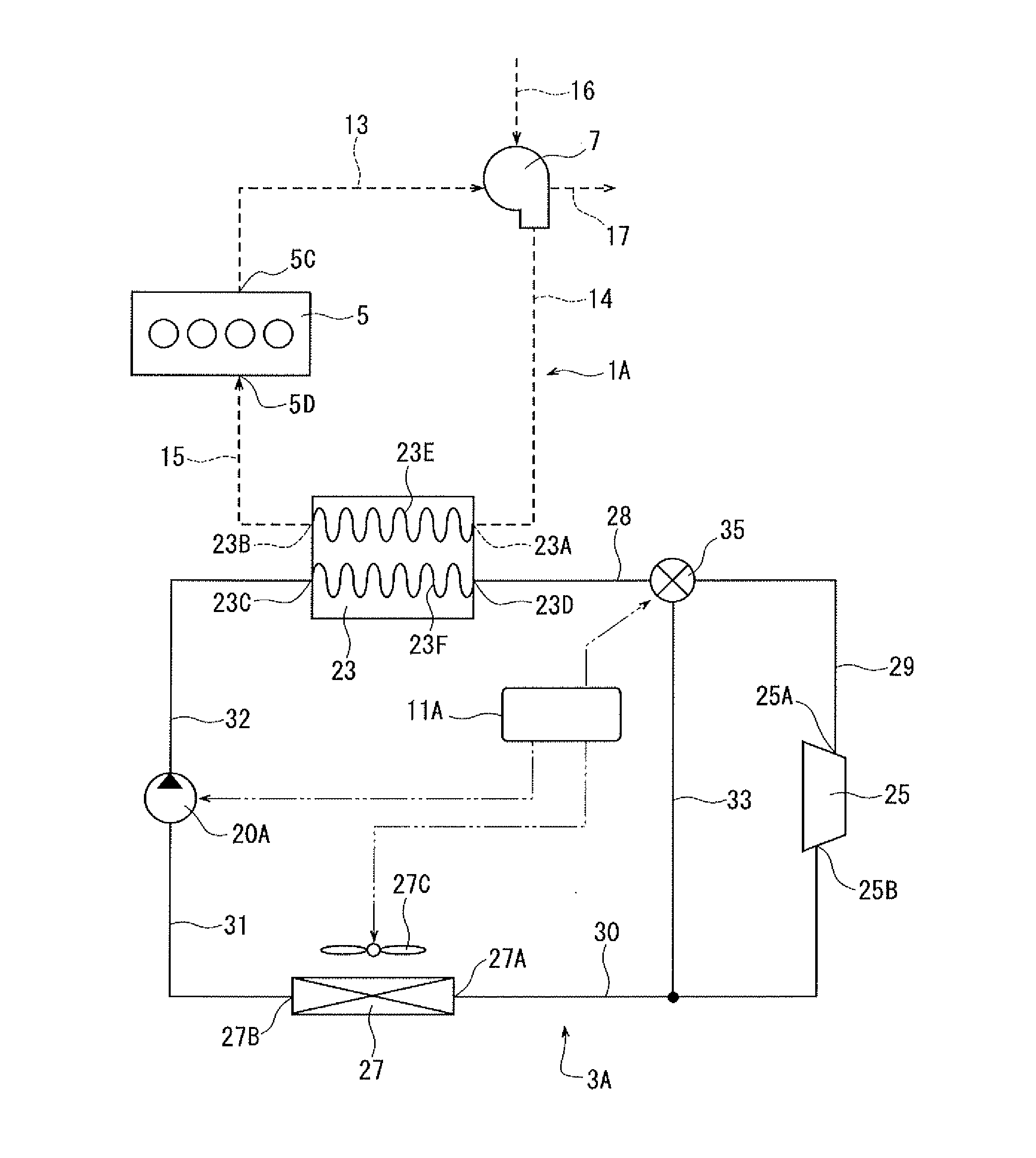Waste heat recovery system
a heat recovery system and waste heat technology, applied in the direction of mechanical equipment, machines/engines, non-fuel substance addition to fuel, etc., can solve the problems of not obtaining the required engine output, the nitrogen oxides in the exhaust gas cannot be efficiently reduced, and the recirculation exhaust gas or the compressed air cannot be sufficiently cooled in the exhaust gas boiler or the compressed air boiler, etc., to achieve the effect of reducing evaporation pressure and reducing evaporation pressur
- Summary
- Abstract
- Description
- Claims
- Application Information
AI Technical Summary
Benefits of technology
Problems solved by technology
Method used
Image
Examples
first embodiment
[0024]Referring to FIG. 1, the waste heat recovery system of the first embodiment is installed in a vehicle and used with a power unit 1A of the vehicle. The waste heat recovery system includes a Rankine cycle device 3A, a bypass passage 33, a regulator valve 35 and a controller 11A. The bypass passage 33 and the regulator valve 35 correspond to the pressure reducing device of the present invention. The controller 11A corresponds to the determination device of the present invention.
[0025]The power unit 1A has an internal combustion engine 5 and a turbocharger 7 as a forced-induction compressor. The engine 5 is a conventional water-cooled gasoline engine having a water jacket (not shown) through which coolant flows. The engine 5 has an outlet 5C for discharging exhaust gas and an inlet 5D for introducing compressed air.
[0026]The turbocharger 7 is of a widely used type. The turbocharger 7 is driven by the exhaust gas exiting the engine 5 to compress the intake air. Compressed air is s...
second embodiment
[0051]In the system of the second embodiment, if the controller 11A determines that the required cooling load for compressed air exceeds a predetermined threshold, the controller 11A cooperates with the electric motor M to decrease the speed of the pump 20B so that the flow rate of working fluid discharged from the pump 20B decreases. By doing so, the flow rate of the working fluid discharged from the pump 20B becomes relatively lower than that of the working fluid flowing into the expander 25, thereby reducing the evaporation pressure of the Rankine cycle device 3A.
[0052]Thus, the second embodiment also provides the advantages similar to those of the first embodiment.
[0053]FIG. 5 shows the third embodiment of the waste heat recovery system. The third embodiment differs from the second embodiment in that a variable displacement pump 20C controlled by the controller 11A is used instead of the pump 20B of the second embodiment. The controller 11A and the pump 20C corresponds to the pr...
third embodiment
[0054]In the system of the third embodiment, if the controller 11A determines that the required cooling load for compressed air exceeds a predetermined threshold, the controller 11A causes the pump 20C to be operated so as to decrease its displacement, that is, to decrease the amount of fluid pumped per revolution of the pump 20C so that the flow rate of working fluid discharged from the pump 20C decreases. By doing so, the flow rate of the working fluid discharged from the pump 20C becomes relatively lower than that of the working fluid flowing into the expander 25, thereby reducing the evaporation pressure of the Rankine cycle device 3A.
[0055]Thus, the third embodiment also provides the advantages similar to those of the first embodiment.
[0056]FIG. 6 shows the fourth embodiment of the waste heat recovery system. The waste heat recovery system of the fourth embodiment is also installed in a vehicle and used with a power unit 1B of the vehicle. The waste heat recovery system include...
PUM
 Login to View More
Login to View More Abstract
Description
Claims
Application Information
 Login to View More
Login to View More - R&D
- Intellectual Property
- Life Sciences
- Materials
- Tech Scout
- Unparalleled Data Quality
- Higher Quality Content
- 60% Fewer Hallucinations
Browse by: Latest US Patents, China's latest patents, Technical Efficacy Thesaurus, Application Domain, Technology Topic, Popular Technical Reports.
© 2025 PatSnap. All rights reserved.Legal|Privacy policy|Modern Slavery Act Transparency Statement|Sitemap|About US| Contact US: help@patsnap.com



